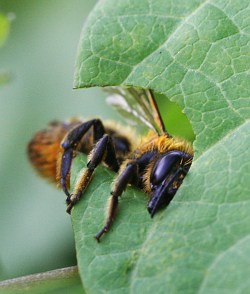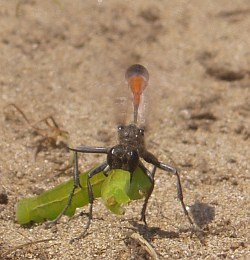Bees and their relatives
Back to the Aculeates page or the main Bees, Wasps and Ants page.

A leaf-cutter bee (Megachile sp.) cuts a distinctive semi-circular hole in a leaf. The leaf sections form the cells of her nest.
There is much more to bees than honey bees and bumble bees. In fact there are 254 species of bees in the British Isles. Bees construct their nests by tunnelling in the earth or by utilizing pre-existing cavities in rotten wood, plant stems or beetle burrows in timber.
Adults and larvae drink nectar, honey and ingest pollen. The pollen is usually collected by females in the branched hairs of the body, although one genus transports its pollen in the crop (an insect's 'pre-stomach'). Most bees are solitary - only the honey bee, bumble bee and some mining bees are truly social.
Leaves with perfectly semi-circular holes on your rose bush indicate the presence of a leaf-cutter bee (Megachile sp.). She makes good use of these leaf fragments, folding and forming them into origami pots. The leaf-cutter visits flowers collecting pollen and nectar to fill her rose-leafed pots with a mixture of honey and pollen for her young. These pots are often placed in excavated tunnels or in old beetle timber burrow; they may be attracted to bee houses made of hollow bamboo canes.
Some of the most beautiful British bees are those which most resemble wasps - the Homeless bees (Nomada spp.). These are kleptoparasites in the nests of other solitary bees (mainly the mining bees Andrena spp.). Nomada are said to release a scent to calm down the owner of the nest in which she lays her eggs.
Also in the Apoidea, the family Sphecidae contains several wasps that are more closely related to bees than to other wasps. Adult sphecids feed at flowers while the larvae are carnivorous. Prey is attacked and stung. In one genus, Oxybelus the dipterous prey is transported impaled upon the female's sting.
A sand digging wasp Ammophila pubescens forms an interesting exception in provisioning the nest with a single caterpillar upon which an egg is laid. The female returns with more caterpillars as the larva grows and thus progressively provision the nest until the larva is fully grown.

The sand digging wasp Ammophila sabulosa with its caterpillar prey
Exciting new guide to the British Coelioxys bees
The guide takes a different approach to complicated keys that are commonly used to identify insects. Many of these keys are not easy for amateurs to use and this hampers insect recording.
This key focuses on the Coelioxys bees, which have various English names such as the Sharp-tailed Bees, Sharp-abdomen Bees and Sharp-bellied Bees. The bees are also known as cuckoo bees because the larvae grow up on food stolen from Leaf-cutter Bees (Megachile Latreille) or Flower Bees (Anthophora Latreille).
The two authors, Rhian Rowson and Mark Pavett, are very keen to hear feedback on the guide. If you use the guide please send in your comments using our feedback form. We will then pass the information on to the authors.
Back to the Aculeates page or the main Bees, Wasps and Ants page.
A to Z of insects
- Alderflies
- Ants
- Antlions
- Archaeognatha
- Barklice
- Bees
- Beetles
- Biting lice
- Booklice
- Butterflies
- Bugs
- Caddisflies
- Cockroaches
- Crickets
- Damselflies
- Dobsonflies
- Dragonflies
- Earwigs
- Fleas
- Flies
- Grasshoppers
- Lacewings
- Leaf insects
- Lice
- Mantids
- Mayflies
- Moths
- Praying Mantids
- Scorpionflies
- Snakeflies
- Stick insects
- Stoneflies
- Strepsipterans
- Sucking lice
- Termites
- Three-pronged bristletails
- Thrips
- True Bugs
- Wasps
- Web-spinners
- Zorapterans
- Non-insect hexapods
- Proturans
- Springtails
- Two-pronged bristletails
![Amateur Entomologists' Society home page [Logo]](/images/aes-logo-wplant.gif)